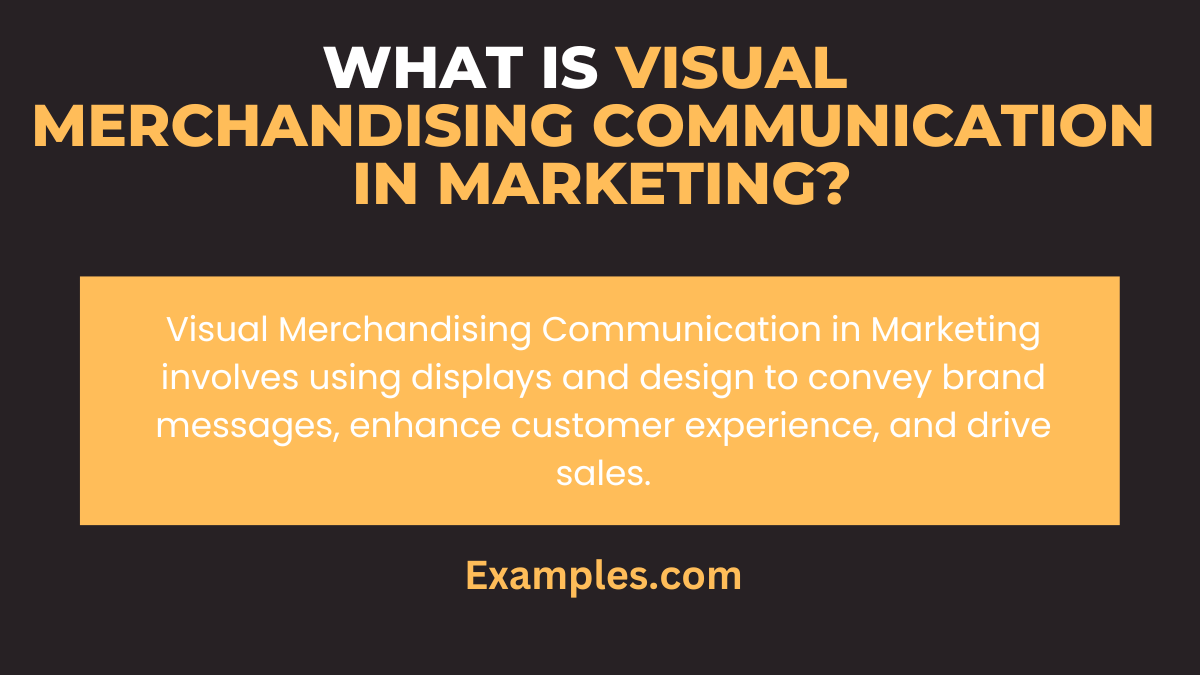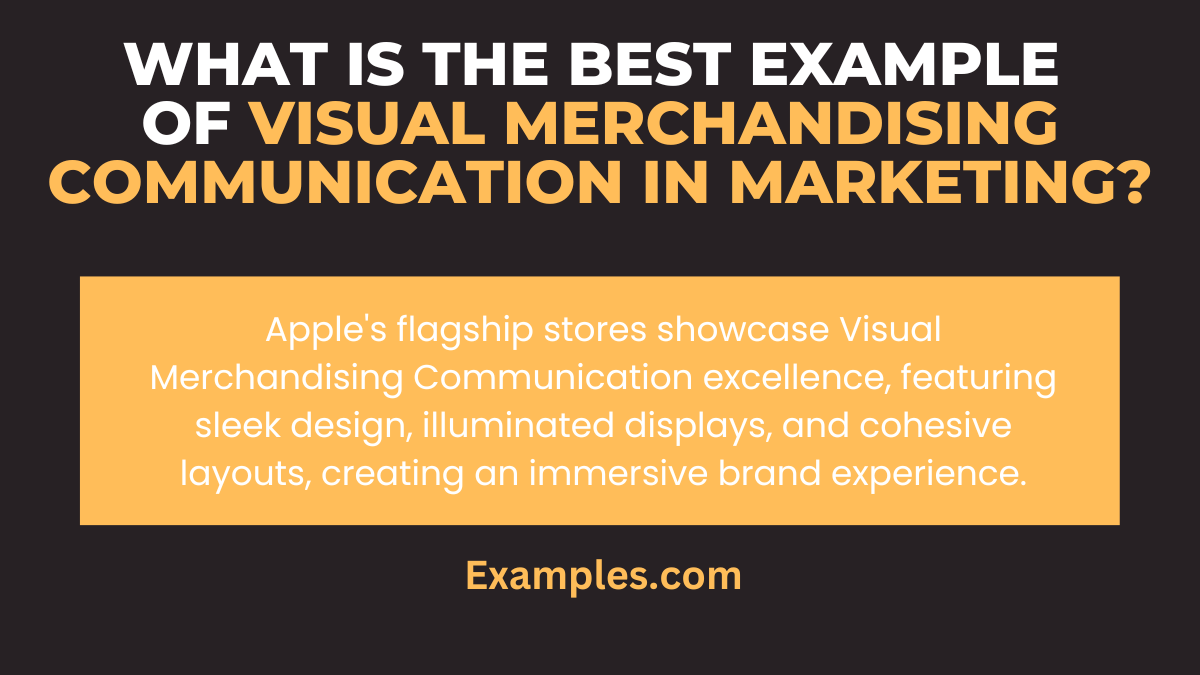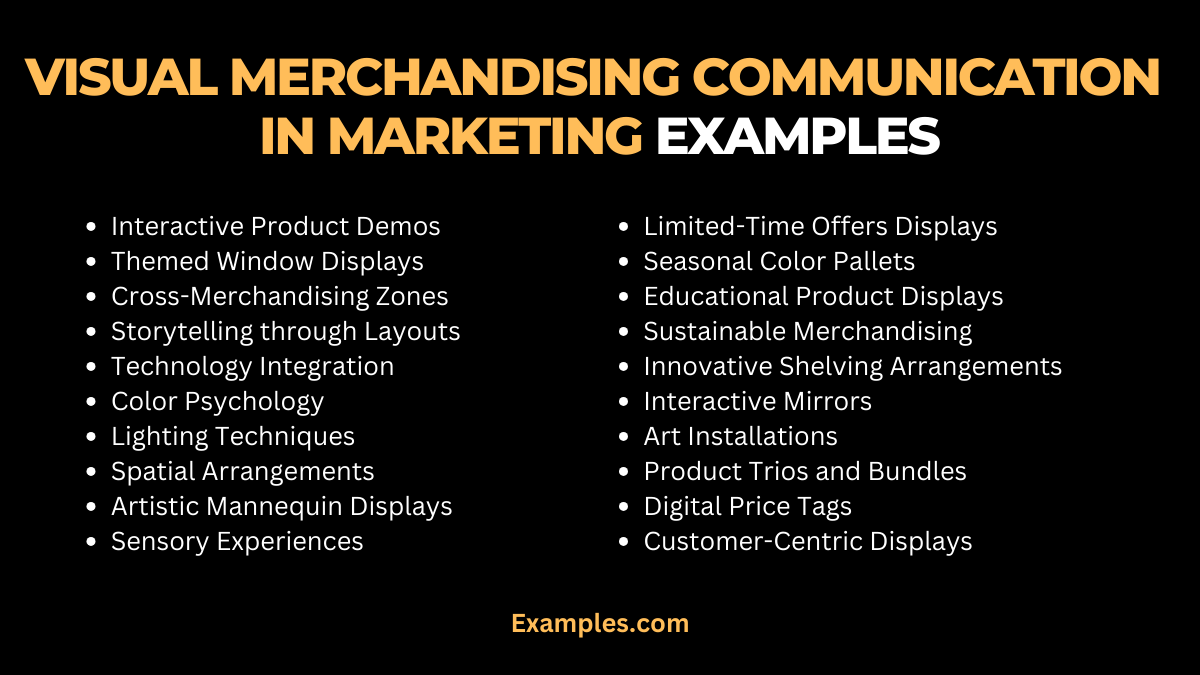19+ Visual Merchandising Communication in Marketing Examples
Dive into the dynamic world of Visual Merchandising Communication in Marketing with our comprehensive guide! This in-depth exploration unveils effective strategies, key tips, and impactful examples to enhance your brand’s communication prowess. Uncover the power of captivating visuals and learn how to strategically integrate them into your marketing endeavors. Elevate your communication game and create lasting impressions with our expert insights. Get ready to transform your approach and witness the magic of Communication Examples in visual merchandising!
What is Visual Merchandising Communication in Marketing?

Visual Merchandising Communication in Marketing refers to the strategic use of visual elements to convey messages, evoke emotions, and enhance brand communication within a retail or promotional space. It involves the thoughtful arrangement of displays, signage, and aesthetics to create a compelling and cohesive brand narrative. Through the deliberate use of visuals, businesses aim to capture attention, communicate their brand identity, and influence consumer behavior, fostering a memorable and engaging experience.
What is the Best Example of Visual Merchandising Communication in Marketing?

Apple’s flagship stores stand out as a prime example of Visual Merchandising Communication excellence. The sleek, minimalist design, illuminated product displays, and carefully curated layouts create an immersive brand experience. The strategic placement of products encourages hands-on interaction, emphasizing the brand’s commitment to innovation. The cohesive visual language across stores worldwide reinforces Apple’s identity, fostering a strong connection with customers. This exceptional execution of Visual Merchandising enhances the overall marketing strategy, creating a harmonious blend of aesthetics and product communication.
20 Visual Merchandising Communication in Marketing Examples

Unleash the power of Visual Merchandising Communication in Marketing with these 20 stellar examples. From captivating window displays to interactive in-store layouts, each example showcases innovative strategies to effectively convey brand messages.
- Interactive Product Demos: Elevate engagement by offering hands-on experiences, communicating product features effortlessly.
- Themed Window Displays: Captivate passersby with seasonal or thematic displays, communicating brand creativity and relevance.
- Cross-Merchandising Zones: Foster product synergy by strategically grouping items, facilitating cross-selling communication.
- Storytelling through Layouts: Create narrative-driven displays, effectively communicating brand stories and values.
- Technology Integration: Incorporate digital displays for dynamic content, enhancing communication through multimedia experiences.
- Color Psychology: Utilize color schemes to evoke emotions, effectively communicating brand personality.
- Lighting Techniques: Play with lighting to highlight key products, subtly communicating focus and importance.
- Spatial Arrangements: Optimize store layout to guide flow, seamlessly communicating product categories and creating a logical shopping journey.
- Artistic Mannequin Displays: Craft visually appealing mannequin setups, communicating style and fashion inspiration.
- Sensory Experiences: Engage multiple senses through scents or background music, enhancing the overall communication ambiance.
- Limited-Time Offers Displays: Create urgency and communicate exclusivity through limited-time promotion displays.
- Seasonal Color Pallets: Adapt displays to seasonal color trends, subtly communicating product relevance and freshness.
- Educational Product Displays: Integrate informative signage to educate customers, effectively communicating product benefits.
- Sustainable Merchandising: Showcase eco-friendly practices, communicating the brand’s commitment to sustainability.
- Innovative Shelving Arrangements: Experiment with non-traditional shelving, communicating uniqueness and modernity.
- Interactive Mirrors: Incorporate mirrors with interactive features, offering real-time communication of product enhancements.
- Art Installations: Integrate artistic displays, effectively communicating brand culture and creativity.
- Product Trios and Bundles: Communicate complementary product pairings through strategic grouping.
- Digital Price Tags: Enhance pricing communication with dynamic digital displays for real-time updates.
- Customer-Centric Displays: Tailor displays to reflect customer lifestyles, effectively communicating relatability and connection.
Visual Merchandising Communication in Marketing Examples for Business
Enhance your business’s brand communication with these dynamic Visual Merchandising strategies. From interactive displays to thematic arrangements, each example offers a unique way to connect with your audience and drive marketing success.
1. Interactive Digital Catalogs: Elevate engagement by incorporating touch-screen catalogs, allowing customers to explore products seamlessly.
2. Customer Journey Displays: Create visual narratives reflecting the customer journey, effectively communicating the brand’s commitment to understanding and meeting consumer needs.
3. Virtual Try-On Stations: Implement augmented reality mirrors for virtual product trials, offering an innovative way to communicate product fit and style.
4. Pop-Up Experiences: Set up temporary installations for exclusive product launches or events, creating a buzz and communicating a sense of urgency.
5. Social Media Integration Displays: Showcase user-generated content and social media feeds in-store, bridging online and offline communication channels for an immersive brand experience.
Visual Merchandising Communication in Marketing Examples at a Company
Transform your company’s physical space into a compelling marketing tool with these Visual Merchandising examples. From employee-centric displays to innovative product showcases, these strategies communicate your brand ethos effectively.
1. Employee Recognition Wall: Showcase employee achievements and milestones visually, fostering a positive company culture and reinforcing internal communication.
2. Innovations Hub Display: Dedicate a section to highlight the company’s latest innovations, communicating a commitment to progress and cutting-edge solutions.
3. Brand Heritage Corner: Create a display featuring the company’s history and milestones, effectively communicating longevity and building a sense of trust with clients and employees.
4. Product Development Showcases: Demonstrate the evolution of products from concept to completion, communicating the company’s dedication to quality and innovation.
5. Employee Showcase Days: Designate days for employees to display personal hobbies or talents in the workplace, fostering camaraderie and enhancing internal communication through shared interests.
What Techniques can be employed in Visual Merchandising to strengthen Communication within a Marketing Context?
Several techniques can be employed in Visual Merchandising to bolster communication within a marketing context:
- Thematic Storytelling Displays: Craft displays that tell a cohesive narrative, effectively communicating brand stories and values.
- Interactive Product Demos: Engage customers by offering interactive demonstrations, allowing them to experience and better understand the product.
- Strategic Signage Placement: Use signage strategically to guide customers through the store, communicating promotions, features, and brand messages.
- Color Psychology Integration: Leverage color psychology to evoke emotions and communicate specific brand attributes, creating a visually appealing and emotionally resonant atmosphere.
- Consistent Branding Elements: Ensure consistency in branding elements such as logos, fonts, and colors across displays, reinforcing brand identity and facilitating seamless communication.
- Digital Integration with AR/VR: Explore digital integration with augmented or virtual reality to provide immersive experiences, effectively communicating product details and features.
- Customer-Centric Layouts: Design store layouts with the customer journey in mind, facilitating easy navigation and enhancing communication of product categories and offerings.
How does Visual Merchandising contribute to effective Communication in Marketing?
Visual Merchandising plays a vital role in effective marketing communication, creating an immersive experience that resonates with customers. Here’s a concise guide:
- Atmosphere Creation: Craft inviting spaces aligning with the brand, setting the stage for effective communication.
- Attention-Grabbing Displays: Draw customers in with eye-catching visuals, initiating brand communication.
- Brand Personality: Strategically showcase products to convey the brand’s personality and connect with the audience.
- Guided Customer Journey: Layouts influence how customers interact with products, enhancing communication.
- Product Representation: Tangible displays communicate product features, benefits, and unique selling points.
- Showcasing Brand Values: Thematic displays convey brand values, fostering emotional connections.
- Seasonal Adaptation: Timely adjustments to displays align with seasonal campaigns and market trends.
- Emotional Connection: Aesthetic appeal contributes to emotional connections, vital for effective communication.
- Consistent Messaging: Ensure visual consistency across touchpoints for a cohesive brand message.
- Technology Integration: Incorporate digital elements for dynamic content and enhanced engagement.
What Role does Visual Merchandising Play in the Communication Strategies of marketing?
Visual merchandising is a strategic element that amplifies marketing communication. Here’s a succinct guide:
- Reinforcing Brand Messages: Translate brand narratives into memorable visual experiences for effective communication.
- Standing Out in the Market: Unique displays capture attention, supporting effective communication in a crowded market.
- Supporting Product Launches: Visuals become a crucial part of product launch communication, visually compelling and memorable.
- Demographic Tailoring: Tailor displays to specific demographics for more resonant communication.
- Branded Shopping Experience: Transform shopping into a memorable, branded experience, aligning with communication strategies.
- Driving Impulse Purchases: Strategically placed items and enticing displays contribute to communication, driving impulse purchases.
- Cross-Selling Opportunities: Layouts encourage cross-selling, enhancing communication by exposing customers to complementary products.
- Campaign Alignment: Seamless integration with marketing campaigns provides visual extensions of campaign themes and messages.
- Seasonal and Trend Adaptations: Timely adjustments to displays align with marketing strategy, ensuring current and relevant communication.
- Measuring Impact: Assess the impact of visual merchandising on communication, optimizing future efforts for better results.
In conclusion, Visual Merchandising is an indispensable component of successful marketing communication. By employing strategic displays, businesses can captivate audiences, convey brand messages, and create memorable experiences. The comprehensive guide and diverse examples presented offer valuable insights, empowering marketers to harness the power of visual merchandising and elevate their communication strategies for lasting impact and consumer engagement.



